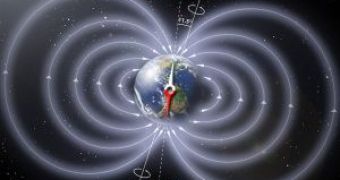The Earth has a magnetosphere that affects the life of most creatures on Earth. Earth's magnetism is very weak, from 0.3 gauss at the Equator to 0.7 gauss at the Poles.
Researchers discovered magnetic bacteria living in the ponds and lakes, presenting a chain of magnetic crystals inside their cells. Those located in the Northern Hemisphere swim in the direction of the magnetic north, while those from the Southern Hemisphere swim in the direction of the magnetic south (these bacteria live in environments with poor oxygen supply).
Plant seeds do not germinate in Cosmos, as they must feel the terrestrial magnetic field so their cells can be activated. When seeds are put in a more powerful magnetic field than that of the Earth, a 15 % increase of the production was caused.
If bees are subjected to a magnetic field ten times more powerful than the terrestrial one, they are completely disoriented, and the combs get unusual forms and orientations. They possess tinny magnetite crystals, of 300 angstroms (one angstrom is a tenth billionth part of a mm).
Migratory fishes like trout, salmons and stingrays, have sensory cells containing magnetite, which are wired to the brain. Whales and dolphins were found to use Earth's electromagnetism in their long migrations (the echolocation of the dolphins serves only for short distances). Impairments in the Earth's magnetic field could explain massive cetacean strands in specific areas.
Sharks and rays have electromagnetic sensors, employed for detecting wounded fish and crustaceans that emit a weak electric field, even of just 0.01 microvolts. Sharks moving through the terrestrial magnetic field generate an electric field whose value depends on their position of the magnetic field captured by the electroreceptors. In an aquarium, sharks always swim around the walls. If the magnetic field is canceled or impaired, they start swimming randomly.
Lab mice that had formed the conditional reflex of pressing a flap to get food any time they wanted to eat lost their reflex after being kept for 10 days in a room were the terrestrial magnetism was impaired. It was like their memory had been erased.
The bird case
In 2004, tiny deposits of a mineral called magnetite (lodestone) were discovered in the beaks of pigeons and bobolink (a North American songbird). If a small magnet impairs their reception of the Earth's magnetism or the area has a natural disturbance of the terrestrial magnetism, pigeons get disoriented and cannot find the way back on long distances.
European robins on other 20 songbirds and pigeons were proven to rely on Earth's magnetic field to navigate during their seasonal migrations. In fact, migratory birds are believed to use magnetism, rather than sight, to make their long journeys. Birds and many non-mammal magnetic sensitive animals are known to perceive the inclination, using the Earth's magnetic field inclination to assess relative latitude. This angle is 90 degrees at the poles (perpendicular to the Earth) and 0 degrees in the equatorial area (parallel to the Earth). There are bird species, like the Arctic Tern, which use this information to make annual journeys from the North Pole to the South Pole and back.
The researchers put the magnetism detection on light exposure, magnetite receptors, or both. Chickens detect the terrestrial magnetism as well, and their magnetic sensors could be in the eye. This presumption is based on an experiment that revealed that the birds could orient themselves under blue light, but totally lost the sense of direction under longer-wavelength lighting.
The order of the chickens (Galliformes) and that of the robins (Passeriformes) split from a common group more than 66 million years ago. As both groups possess a similar magnetic compass, this means birds developed this ability early in their evolution, long before the migration behavior emerged.
Birds can employ a light-connected mechanism in the right eye for directional information, and a magnetite receptor in the upper beak for perceiving the changes in magnetic intensity.
Sea turtles and magnetism
Marine turtles use to return their entire life to the same breeding beach, often located thousands of kilometers off the feeding places, making the return with no visual landmarks.
The turtles' exceptional navigational ability relies on detecting the earth's magnetic field, against the deflection induced by the ocean currents, as it was proved in green turtles (Chelonia mydas). If a powerful magnet attached on the turtles' heads impairs the detection of the Earth's magnetism, the turtles decrease their navigational sense.
They were still able to return to their original egg-laying beach, thus the turtles do not rely only on the geomagnetic field. They probably use olfaction, like some sea birds (petrels and albatrosses) or homing pigeons do, but this is just a supposition by now.
Tests made on captive young sea turtles showed that increasing with 10% the magnetic field compared to the natural one made the animals to swim eastward, while a 10% lower magnetic field made them swim westward. Sea turtles are also known to react to sudden changes in the terrestrial magnetism and to its inclination, too.
Bats and the magnetic field
The magnetic compass, using the terrestrial magnetism, is also used by moles, rats, fish, amphibians. Bats have it too, and they detect the difference between north and south. They use the terrestrial magnetism for long-distance navigation (some bats like Nyctalus noctula, can migrate up to 1600 km (1000 mi) to wintering places) and foraging abilities. Bats do not employ the field's angle, but its polarity. But when the horizontal field was shifted, the bats also changed their hanging positions, from the northern to the southern edges of their basket. A 2007 research showed that bats use magnetite receptors.

 14 DAY TRIAL //
14 DAY TRIAL //